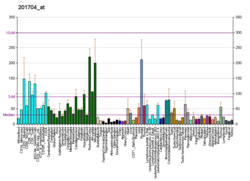| ENTPD6 |
|---|
|
| Identifiers |
|---|
| Aliases | ENTPD6, CD39L2, IL-6SAG, IL6ST2, NTPDase-6, dJ738P15.3, ectonucleoside triphosphate diphosphohydrolase 6 (putative), ectonucleoside triphosphate diphosphohydrolase 6 |
|---|
| External IDs | OMIM: 603160; MGI: 1202295; HomoloGene: 68170; GeneCards: ENTPD6; OMA:ENTPD6 - orthologs |
|---|
| Gene location (Human) |
|---|
 | | Chr. | Chromosome 20 (human)[1] |
|---|
| | Band | 20p11.21 | Start | 25,195,693 bp[1] |
|---|
| End | 25,228,075 bp[1] |
|---|
|
| Gene location (Mouse) |
|---|
 | | Chr. | Chromosome 2 (mouse)[2] |
|---|
| | Band | 2|2 G3 | Start | 150,749,042 bp[2] |
|---|
| End | 150,771,675 bp[2] |
|---|
|
| RNA expression pattern |
|---|
| Bgee | | Human | Mouse (ortholog) |
|---|
| Top expressed in | - nucleus accumbens
- middle frontal gyrus
- anterior pituitary
- caudate nucleus
- prefrontal cortex
- Brodmann area 10
- right adrenal gland
- Brodmann area 9
- cingulate gyrus
- minor salivary glands
|
| | Top expressed in | - spermatocyte
- spermatid
- seminiferous tubule
- dorsomedial hypothalamic nucleus
- subiculum
- paraventricular nucleus of hypothalamus
- ventromedial nucleus
- lateral hypothalamus
- arcuate nucleus
- seminal vesicula
|
| | More reference expression data |
|
|---|
| BioGPS |  | | More reference expression data |
|
|---|
|
| Gene ontology |
|---|
| Molecular function | - nucleoside-triphosphatase activity
- guanosine-5'-triphosphate,3'-diphosphate diphosphatase activity
- uridine-diphosphatase activity
- hydrolase activity
- nucleoside-diphosphatase activity
| | Cellular component | - integral component of membrane
- cell surface
- Golgi membrane
- plasma membrane
- membrane
- extracellular region
- extracellular space
- Golgi apparatus
| | Biological process | - response to calcium ion
- response to magnesium ion
- nucleobase-containing small molecule catabolic process
- metabolism
| | Sources:Amigo / QuickGO |
|
| Orthologs |
|---|
| Species | Human | Mouse |
|---|
| Entrez | | |
|---|
| Ensembl | | |
|---|
| UniProt | | |
|---|
| RefSeq (mRNA) | NM_001114089
NM_001247
NM_001317941
NM_001322378
NM_001322379
|
|---|
NM_001322380
NM_001322381
NM_001322382
NM_001322383
NM_001322384
NM_001322385
NM_001322386
NM_001322387
NM_001322388
NM_001322389
NM_001322390
NM_001322391
NM_001322392
NM_001322393
NM_001322394
NM_001322395
NM_001322396
NM_001322397
NM_001322398 |
| |
|---|
| RefSeq (protein) | NP_001107561
NP_001238
NP_001304870
NP_001309307
NP_001309308
|
|---|
NP_001309309
NP_001309310
NP_001309311
NP_001309312
NP_001309313
NP_001309314
NP_001309315
NP_001309316
NP_001309317
NP_001309318
NP_001309319
NP_001309320
NP_001309321
NP_001309322
NP_001309323
NP_001309324
NP_001309325
NP_001309326
NP_001309327 |
| |
|---|
NP_742115
NP_001341997
NP_001357558
NP_001357559
NP_001357560 |
|
|---|
| Location (UCSC) | Chr 20: 25.2 – 25.23 Mb | Chr 2: 150.75 – 150.77 Mb |
|---|
| PubMed search | [3] | [4] |
|---|
|
| Wikidata |
| View/Edit Human | View/Edit Mouse |
|


















